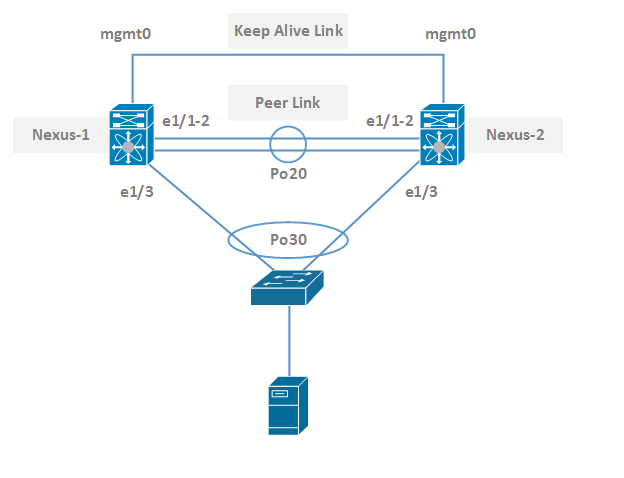參考文件如下
https://www.ciscolive.com/c/dam/r/ciscolive/us/docs/2019/pdf/BRKDCN-2249.pdf
https://www.letsconfig.com/how-to-configure-cisco-nexus-vpc/
VPC 名詞解釋如下:

架構如下

設定
Enabling Features:
First of all, let’s enable necessary features for vPC on both switches.
Nexus-1: Nexus-1(config)# feature vpc Nexus-1(config)# feature lacp Nexus-2: Nexus-2(config)# feature vpc Nexus-2(config)# feature lacp
Keep Alive Link:
For keep alive link, we will use our management interfaces. However, for a larger enterprise network, management interfaces are used for out-of-band management. In that case, you will need to use other ports.
Nexus-1: Nexus-1(config)# interface mgmt 0 Nexus-1(config-if)# ip address 10.1.1.1/30 Nexus-1(config-if)# no shutdown Nexus-2: Nexus-2(config)# interface mgmt 0 Nexus-2(config-if)# ip address 10.1.1.2/30 Nexus-2(config-if)# no shutdown
To verify the connectivity, we can ping from Nexus-1 to Nexus-2 management IP.
Nexus-1# ping 10.1.1.2 vrf management PING 10.1.1.2 (10.1.1.2): 56 data bytes 36 bytes from 1.1.1.1: Destination Host Unreachable Request 0 timed out 64 bytes from 10.1.1.2: icmp_seq=1 ttl=254 time=1.098 ms 64 bytes from 10.1.1.2: icmp_seq=2 ttl=254 time=0.598 ms 64 bytes from 10.1.1.2: icmp_seq=3 ttl=254 time=0.536 ms 64 bytes from 10.1.1.2: icmp_seq=4 ttl=254 time=0.503 ms --- 10.1.1.2 ping statistics --- 5 packets transmitted, 4 packets received, 20.00% packet loss round-trip min/avg/max = 0.503/0.683/1.098 ms
vPC Domain:
A vPC domain is a collection of vPC component. In this example, we will be using vPC domain 1. You can choose domain id between <1-1000>. And, also we will set priorities for both switches. Lower priority will become primary.
Nexus-1: Nexus-1(config)# vpc domain 1 Nexus-1(config-vpc-domain)# role priority 20 Nexus-1(config-vpc-domain)# peer-keepalive destination 10.1.1.2 source 10.1.1.1 vrf management Nexus-1(config-vpc-domain)# Nexus-2: Nexus-2(config)# vpc domain 1 Nexus-1(config-vpc-domain)# role priority 30 Nexus-2(config-vpc-domain)# peer-keepalive destination 10.1.1.1 source 10.1.1.2 vrf management Nexus-2(config-vpc-domain)#
Peer Link:
The peer link exchanges state information and carries control traffic between peer nexus switches.
Nexus-1: Nexus-1(config)# interface ethernet 1/1-2 Nexus-1(config-if-range)# channel-group 20 mode active Nexus-1(config-if-range)# no shutdown Nexus-1(config)# interface port-channel 20 Nexus-1(config-if)# no shutdown Nexus-1(config-if)# switchport Nexus-1(config-if)# switchport mode trunk Nexus-1(config-if)# vpc peer-link Nexus-2: Nexus-2(config)# interface ethernet 1/1-2 Nexus-2(config-if-range)# channel-group 20 mode active Nexus-1(config-if-range)# no shutdown Nexus-2(config)# interface port-channel 20 Nexus-2(config-if)# no shut Nexus-2(config-if)# switchport Nexus-2(config-if)# switchport mode trunk Nexus-2(config-if)# vpc peer-link
To verify, use need to use, “show vpc brief” command.
Nexus-1# show vpc brief
Legend:
(*) - local vPC is down, forwarding via vPC peer-link
vPC domain id : 1
Peer status : peer adjacency formed ok
vPC keep-alive status : peer is alive
Configuration consistency status : success
Per-vlan consistency status : success
Type-2 consistency status : success
vPC role : primary
Number of vPCs configured : 0
Peer Gateway : Disabled
Dual-active excluded VLANs : -
Graceful Consistency Check : Enabled
Auto-recovery status : Disabled
Delay-restore status : Timer is off.(timeout = 30s)
Delay-restore SVI status : Timer is off.(timeout = 10s)
Operational Layer3 Peer-router : Disabled
vPC Peer-link status
---------------------------------------------------------------------
id Port Status Active vlans
-- ---- ------ -------------------------------------------------
1 Po20 up 1
Member Ports:
Member ports are the ports where end device is connected. We need to configure port-channel for the end device.
Nexus-1: Nexus-1(config)# interface eth 1/3 Nexus-1(config-if)# channel-group 30 mode active ! Nexus-1(config-if)# interface port-channel 30 Nexus-1(config-if)# switchport Nexus-1(config-if)# vpc 30 Nexus-2: Nexus-2(config)# interface eth 1/3 Nexus-2(config-if)# channel-group 30 mode active ! Nexus-2(config-if)# interface port-channel 30 Nexus-2(config-if)# switchport Nexus-2(config-if)# vpc 30
Let’s verify VPC member.
Nexus-1# show vpc brief
Legend:
(*) - local vPC is down, forwarding via vPC peer-link
vPC domain id : 1
Peer status : peer adjacency formed ok
vPC keep-alive status : peer is alive
Configuration consistency status : success
Per-vlan consistency status : success
Type-2 consistency status : success
vPC role : primary
Number of vPCs configured : 1
Peer Gateway : Disabled
Dual-active excluded VLANs : -
Graceful Consistency Check : Enabled
Auto-recovery status : Disabled
Delay-restore status : Timer is off.(timeout = 30s)
Delay-restore SVI status : Timer is off.(timeout = 10s)
Operational Layer3 Peer-router : Disabled
vPC Peer-link status
---------------------------------------------------------------------
id Port Status Active vlans
-- ---- ------ -------------------------------------------------
1 Po20 up 1
vPC status
----------------------------------------------------------------------------
Id Port Status Consistency Reason Active vlans
-- ------------ ------ ----------- ------ ---------------
20 Po30 down* success success -